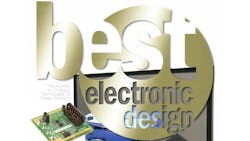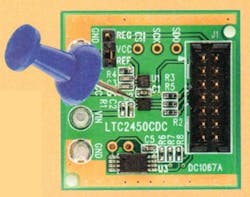Designers can calculate the analog-to-digital converter (ADC) figure of merit (FOM), based on power consumption, effective number of bits (ENOB), and sampling frequency. But interpreting an expression for pJ/conversion doesn't really say anything about an ADC's appropriateness for an actual application.
The High
Let's start with the dazzlers, those super-fast chips with wide dynamic range intended to move digital downconversion as far up the receiver signal chain as possible.
Last summer, National Semiconductor announced 170- and 155-Msample/s ADCs for wireless infrastructure. There were two 12-bit chips: the CMOS-output ADC12C170 and the LVDS-output (low-voltage differential signaling) ADC12V170. Also announced was the 14-bit ADC14V155, which runs at 155 Msamples/s.
Key specs at a 70-MHz input for the 12-bit ADCs include 85.4-dB spuriousfree dynamic range (SFDR) and 67.2-dB signal-to-noise ratio (SNR) for the one with CMOS output and 85.8-dB SFDR and 67.2-dB SNR for the one with LVDS output. The 14-bit chip boasts 85-dB SFDR and 69.5-dB SNR.
During the same timeframe, MIT-spinoff Kenet Inc. introduced the 12-bit, 500-Msample/s KAD5512-50 and the 14-bit, 250-Msample/s KAD5514-25. At Nyquist, the former boasts 70-dB SFDR and 66.3-dB SNR.
Meanwhile, Texas Instruments announced a 14-bit, 400-Msample/s ADC with an integrated front-end buffer, the ADS5474. It's a higher-resolution complement to an already announced 12-bit, 500-Msample/s part. TI emphasizes the converter's 70-dBFS SNR through first Nyquist and 69-dBFS SNR through second Nyquist.
In mid-2007, Maxim Integrated Products came out with the silicon-germanium (SiGe), 8-bit, 2.2-Gsample/s MAX109 with integrated track-andhold. At maximum sample rate and a 300-MHz input frequency, the ADC achieves 62-dBc SFDR and 45-dB SNR. That SNR remains flat (within 1.6 dB) for input frequencies up to 2 GHz.
Last December, Analog Devices offered its candidate for the best, the dual 14-bit, 150-Msample/s AD9640, which provides a 70-MHz input 85-dBc SFDR and 72.7-dBFS SNR. One unique feature is that the ADC divides down its input clock internally. Usually, such ADCs require the division to take place off-chip. It also integrates an automatic gain control (AGC) block.
That lineup from 2007 ignores a line of 8-bit, 1.5-Gsample/s ADCs that National introduced in 2006. That product family includes an interleaved dual-device package that kicks the effective sampling rate up to 3 Gsamples/s.
Looking at these announcements, we see there are tradeoffs between resolution and speed that make it hard to pick the "bestâ" chip. Cost and power consumption aren't even included in the brief comparison above.
The Mighty
Moving down the ADC input frequency spectrum, Austria Microsystems introduced 10- and 12-bit, 150-ksample/s ADCs for battery- powered data-acquisition systems in 2007.
The 10-bit AS1528 and AS1529 are spec'd at 0.275-LSB (max) integral and differential nonlinearity and 25-LSB gain error and 79.5-dB total harmonic distortion (THD) while drawing 350 µA (at 3 V) at the full sampling rate, 245 µA at 100 ksamples/s, 2.5 µA at ksamples/s, and 200 nA during shutdown. The AS1528 has differential input, and the AS1529 is single-ended.
For professional audio recording, TI introduced the PCM4220 and PCM4222, a pair of 24-bit, 216-kHz ADCs. They deliver up to 124-dB SNR and integrate an on-chip, linear phase decimation filtering engine that supports either classic or low groupdelay filter responses, so designers can optimize the device for studio or live sound. "Low power" in this case means 305 mW at 48 kHz, but that's still low enough to allow an audio interface over USB or FireWire.
In applications such as portable medical devices, conversion rates go even lower. To serve the needs of that area, Linear Technology came up with what must constitute the smallest-footprint (2 by 2 mm) and potentially the slowest ADC of the year, the 16-bit, 30-Hz LTC2450 (see the figure).
Its specs include 2-LSB integral nonlinearity (INL), 1.4-µVRMS noise, and 0.01% gain error. With a 2.7- to 5.5-V supply, the LTC2450 draws 500 µA when it's operating and down to less than 1 µA in shutdown. By controlling the duration between conversions, power dissipation can be reduced to 50 µW at a 1 Hz. For some applications, slowest is best.

